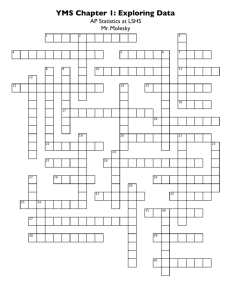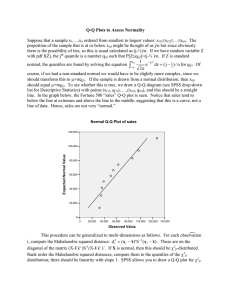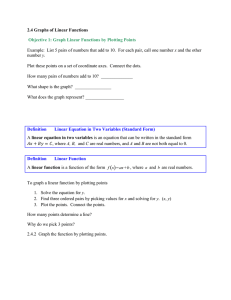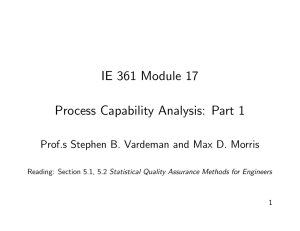Normal Plotting for Process Characterization (Section 5.1 of Vardeman and Jobe) 1
advertisement
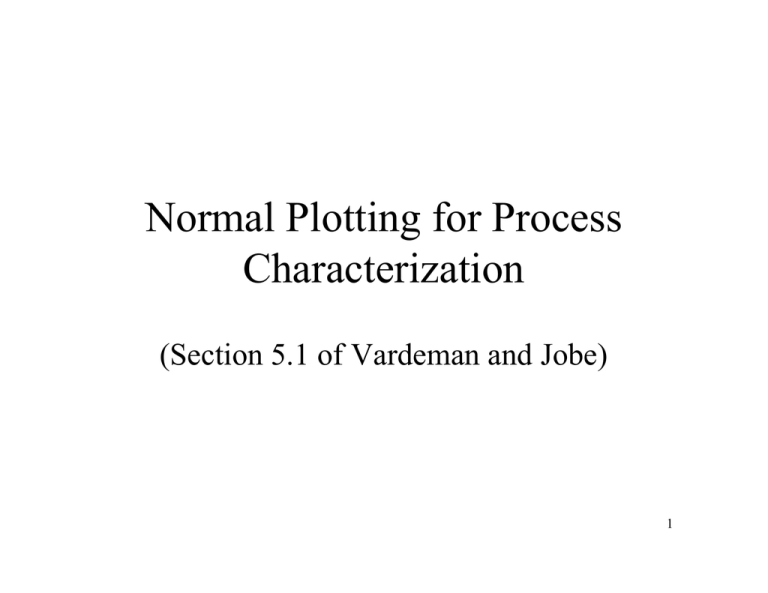
Normal Plotting for Process
Characterization
(Section 5.1 of Vardeman and Jobe)
1
When is a Data Set More Than
Just a Data Set?
• Only when it comes from some kind of
(physically) “stable” system
• Perfect consistency is too much to expect in
this world
• If (by virtue of process monitoring and wise
intervention) I am willing to claim that a
data set represents a stable process, I may
want to use it to characterize its output
2
Graphics for Process Shape Use
the Notion of “Quantiles”
• For an ordered data set x1 ≤ x2 ≤ L ≤ xn
– and an integer i and p=(i-.5)/n, the p quantile
of the data set is
i − .5
Q
= xi
n
– and a value p not of the form =(i-.5)/n, the p
quantile of the data set is gotten by linear
interpolation
3
Simple Example
• Data set {2,3,4,4,6}
i − .5
p=
5
i − .5
Q
= xi
5
.1
2=Q(.1)
2
.3
3=Q(.3)
3
.5
4=Q(.5)
4
.7
4=Q(.7)
5
.9
6=Q(.9)
i
1
.02 .02
and, e.g., Q (.32) = 1 − 3 + 4 = 3.1
.2 .2
4
Key Insight and Application
• “Same shape” for two distributions is
“linearly-related quantile functions”
p
.1
Q1 ( p )
2
Q2 ( p )
5
.3
3
7
.5
4
9
.7
4
9
.9
6
13
here Q2 ( p ) = 2Q1 ( p ) + 1
• So plots of (Q1 ( pi ),Q 2 ( pi ) ) might be used to
compare distribution shapes (Q-Q plots) 5
Simple Example
• Q-Q plot for the two
artificial data sets
• Q-Q plot if the
smallest value in
data set #2 is
changed to 0
6
Probability Plotting
• The most important version of Q-Q plotting
is that where the 2nd distribution is a
theoretical one (rather than that of a second
data set) … a Q-Q plot is then a “probability
plot” (and one is checking to see if the
shape of the data set matches the theoretical
shape)
• For an ordered data set x1 ≤ x2 ≤ L ≤ xn
plot
i − .5
x
,
Q
i theoretical n
7
Normal Plotting
• The case where the theoretical distribution
is standard normal is “normal plotting”
e.g., Qz (.1587) = −1.00
i − .5
x
,
Q
i Z n
• Plotting points
gives a way of
checking on “normal shape”
8
Example 5.4 (Data of Table 5.7)
• This plot is fairly linear, so the distribution
shape is “normal” … if the drilling process
is stable, one may treat it as generating
normally distributed angles
9
Example 5.1 (Data of Table 5.1)
• Here the data distribution is long-tail right
(skewed right) in comparison to the normal
shape … a normal model would not be a
good one for describing tongue thickness
10
Normal Plotting in Practice
• It’s rarely done by finding standard normal
quantiles and plotting by hand
– For decades special (normal) “probability
paper” has been used … on it, plot points
i − .5
i − .5
x
,100
or
xi ,
i
n
n
– These days any decent statistical package will
do it automatically
• For linear plots, means and standard
deviations can be read from from the graph
µˆ = horizontal intercept
σˆ = 1/ slope
11
12
Minitab Normal Plot of Angles
13
Graphical Estimates
slope of eye-fit
line is about
1/.983
horizontal intercept
is about 44.117
14
Workshop Exercises
• Find .1,.3,.5,.7 and .9 standard normal
quantiles and use them to make a normal
plot of the small data set on slide 4 on
regular graph paper, plotting points
i − .5
x
,
Q
i Z n
– Read an approximate mean and standard
deviation off your plot
• Normal plot the data set from slide 4 on the
capability analysis sheet of slide 12
– Compare to your plot from above
15
Workshop Exercises
• Interpret the Minitab normal plot of weights
of new pennies (recorded to the nearest .02
gram)
16
